
Table of contents:
- Author Bailey Albertson [email protected].
- Public 2024-01-17 22:26.
- Last modified 2025-01-23 12:41.
Bald cat breeds, or why does an animal need wool

The unusual appearance of cats without hair seems to be very attractive to many. However, in the chorus of enthusiastic reviews, you can hear just as many disappointed and sharply negative ones. Starting a bald cat, people turn out to be completely unprepared for its peculiarities, expecting from the animal the manifestation of those qualities that it does not initially possess. Obtaining general information about how such breeds were created and what the lack of wool turns out to be for the animal and its owner could save those who could not love their pet from a rash step.
Content
- 1 The history of the emergence of hairless cat breeds
-
2 Breeds of hairless cats
-
2.1 Canadian Sphynx
2.1.1 Video: Canadian Sphynx
-
2.2 Don Sphynx
- 2.2.1 Photo gallery: selection of Don Sphynxes
- 2.2.2 Features of the appearance of the Don Sphynxes
- 2.3 Petersburg Sphinx (Peterbald)
-
2.4 Kohona (Hawaiian hairless)
2.4.1 Photo Gallery: Hawaiian Hairless Cat
-
2.5 Ukrainian levkoy
2.5.1 Video: Ukrainian Levkoy
-
2.6 Bambino
2.6.1 Video: Bambino cat
-
2.7 Elf
- 2.7.1 Photo Gallery: Whimsical Elf Colors
- 2.7.2 Video: Elf cat
-
2.8 Dwelf
- 2.8.1 Photo gallery: breeding dwelf
- 2.8.2 Video: Dwelf cat
-
-
3 Bald cat in the house: care features
- 3.1 The myth of hypoallergenic hairless cats
-
3.2 Problems with thermoregulation as a payment for missing wool
- 3.2.1 Protection against cold
- 3.2.2 Sun protection
- 3.2.3 Increased sweating
- 3.2.4 Constant hunger
-
3.3 Health status and most common diseases
3.3.1 Table: hereditary diseases characteristic of hairless cats and their ancestors
- 4 Bald cats: owner reviews
The history of the emergence of hairless cat breeds
Mysterious stories about the origin of hairless cats are retold countless times and wander from one source to another. It seems that no one even thinks about the meaning of what they heard or read. The desire to envelop the breed in a haze of antiquity that excites the imagination is easy to understand: it is much more pleasant to believe that the ancestors of the creature living in your house were not strange monsters born to an ordinary purebred cat, but long-extinct sacred Mexican animals, revered by the Aztecs, or representatives of an unknown Paraguayan breed, who came to South America from Europe in the 16th century and - a statement that made me especially happy - lost their hair under the influence of a warmer climate.

They say that the last two representatives of the Aztec hairless cats were presented by the Indian chief to the European traveler
I would venture to suggest that the Aztec leader (if, of course, this story took place at all) made fun of the naive Mr. Shinik, like the Siamese king over the British, slipping two kittens with congenital abnormalities of the coat to the unlucky European. And the version that cats lost their hair as a result of natural selection, since a warm fur coat was very disturbing for them in the tropics, will surely amuse any owner of the sphinx, who knows perfectly well how much these animals suffer from sunburn. For some reason, no one has heard of what it should have been for hairless animals in the night savannah, at least not about bald cougars and jaguars living in Paraguay.
In reality, the history of hairless cats is not romantic. Such animals have sometimes been found in different parts of the world, including France, Canada, the United States, Australia and, quite possibly, South America. But we are not talking about any special breed, but about a spontaneous mutation, the reasons for which have not yet been fully understood. The “hairless gene” can appear in the offspring of an animal of any breed, for example, in 1938 such kittens were born by a Siamese cat in Paris, and in 1966 - by a mongrel cat in Ontario, Canada. It was this Canadian kitten named Pruno that was destined to become the first "guinea pig", from which his resourceful owners decided to breed a new breed of unusual bald cats.

South American cougar did not lose hair from too hot climate
Bald cat breeds
There are eight breeds of hairless cats in the world today. In four of them, bare or conditionally bare skin is the only distinguishing feature, the rest are a "explosive mixture" of the absence of hair and one or even two, shall we say, unusual features. International felinological organizations have officially recognized only three breeds of sphinxes. Other hairless cats are considered experimental breeds or not recognized at all.
Since the refusal to register a new breed does not at all prevent the "unearthly" creatures from selling very well, there is every reason to believe that the list of bald cat breeds will soon expand.
Canadian sphinx
The Canadian Sphynx is the first hairless cat breed recognized by felinologists. After unsuccessful attempts to cure Pruno, his owners looked closely at the bald kitten and realized: there is a certain charm in the absence of wool. Then Pruno was crossed with his own mother and after a few generations received a new breed of hairless cats, which was enthusiastically recognized by the CFA, one of the most famous international felinological organizations. However, the felinologists soon realized that they were in a hurry. Hairless cats gave birth to weak and mostly unviable offspring, so the breed descended from Pruno did not last long, and the original status assigned to it was hastily withdrawn.
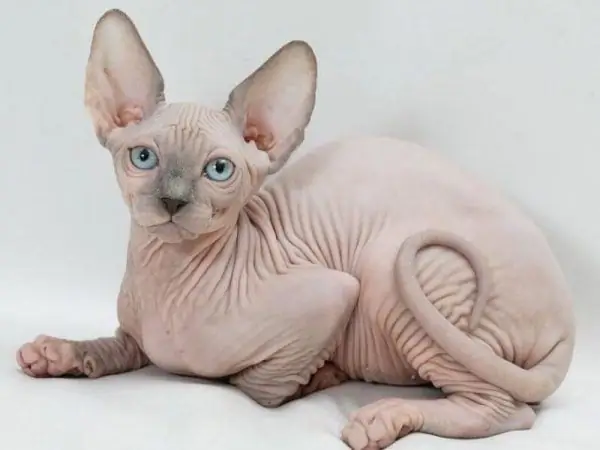
The Canadian Sphynx is the first breed of hairless cats
Fortunately, a few years later a bald kitten, not without black humor called Epidermis, was found in the litter of another cat that lived in America. This time, the enthusiasts approached the selection with greater responsibility. In order to prevent the weakening of the breed due to closely related crosses, Epidermis and the hairless kittens born from it began to mate with Devon Rex - cats with very short wavy hair, which is also the result of mutation.

Thanks to the addition of Devon Rex blood, it was possible to breed a viable hairless cat
The experiments turned out to be more successful, and the breed that appeared as a result of painstaking work was named the Canadian Sphynx. Interestingly, the CFA, which already had the sad experience of meeting bald cats, this time held out to the last, recognizing the Canadian Sphynx much later than other felinological organizations.

The more folds on the skin of the Canadian Sphynx, the higher the animal is valued
In addition to the absence of hair, the hallmark of the Canadian Sphynx is the presence of numerous folds all over the body, as if the cat was pulled the skin several sizes larger than necessary. This quality, unfortunately, is gradually degenerating, and the sphinxes of the European and American lines are becoming more and more similar to the Devon Rex. That is why breeders happily use any bald cat accidentally discovered in breeding work, trying to return the sphinxes to their original appearance and overcome the influence of the Devon Rex blood.
Video: Canadian Sphynx
Don Sphynx
The history of the Don Sphynx is in many ways similar to its Canadian cousin, although it is generally believed that the breeds were created in parallel and independently of each other. Once, a simple teacher from Rostov, returning home, saw how the boys were mocking the unfortunate cat. Having repulsed the animal from the hooligans, the woman noticed that the animal had practically no hair. They took pity on the cat, took it home and named it Barbara. When, after a while, Varvara brought the kittens, in addition to the usual fluffs, there were two naked babies in the litter. It was then that the hostess realized that the absence of hair in the mother-cat is connected not with her hard life, but with some innate feature that must be fixed by creating a new breed. In this process, in addition to hairless kittens from Varvara, local cats participated - Russian blue, Siberian,as well as European shorthairs.
Photo gallery: selection of Don Sphynxes
-

European shorthair cat - The European Shorthair cat participated in the creation of the Don Sphynx breed
-

Siberian cat - How it was possible to consolidate hairlessness by crossing hairless cats with hairy Siberians remains a mystery
-

Russian blue cat - The Russian blue cat gives the Donchaks extra grace
-

Don Sphynx - Donskoy Sphynx - a bald cat of domestic selection
Features of the appearance of the Don Sphynxes
This breed is slightly different from the Canadian in appearance, although the difference is noticeable only to a specialist. If the Canadian Sphynxes only seem to be bald, in reality their skin is covered with very short “suede” wool, then the Donchaks have different types of wool:
- brush - very short and harsh coat;
- velor - thin hairs on the body;
- flock - even finer hairs, almost invisible visually;
- the presence of wool (the gene for hairlessness is not manifested);
- completely bare skin.

Two naked Don Sphynxes cannot be knitted together
The last variation is considered the most valuable, such cats are called plasticine or rubber. Obviously, complete hairlessness is an unviable mutation: plasticine kittens very often die in infancy. The cause of death is the so-called kitten falling asleep syndrome (something like sudden death syndrome in children). The surviving individuals cannot be knitted together, since the offspring from such a mating are doomed.
Petersburg sphinx (peterbald)
The Petersburg Sphinx, also called the Peterbald (from the English bald, that is, "bald"), is a modified variation of the Don. The animal has a narrower muzzle and a very graceful physique due to the addition of the blood of an oriental cat. Everything that has been said about the variants of the wool cover of the Donchaks fully applies to the Peterbald people.

Petersburg Sphinx descended from the Don
Cohona (Hawaiian hairless)
It is impossible to look at this creature without pain. On its body, completely covered with numerous folds, hair is completely absent, there are not even hair follicles. In short, the cohona is the most bald of all bald cats. This breed is also called Hawaiian Hairless or Rubber. In one of the veterinary clinics in Hawaii, five kittens were either thrown or brought to sleep, two of them were completely bald (the word kohana in the local dialect means "naked"). After making sure that the kittens are healthy, the clinic employee took a "rubber" girl and named her Cleopatra.
When the cat grew up, she was crossed with a Canadian Sphynx. On closer examination of the newly born kittens, it was found that their hairlessness is different from that of the sphinxes. The body of the Canadian Sphynx is covered with a wool-like suede, and the "plasticine" Donchaks and Peterbalds do not have so many folds. The syndrome of falling asleep of kittens, which is often found in naked sphinxes, did not spare Hawaiian cats either: one of the three hairless kittens born from the mating of Cleopatra and the Canadian Sphynx (there were six kittens in the litter - three without hair and three with hair), died shortly after birth without visible reasons.
Today there are about four dozen Hawaiian rubber cats in the world. There are kennels for breeding them in Hawaii, Great Britain and the USA (California), but since 2000, when Cleopatra first mated, Shar Pei cats have not gained much popularity.
Image Gallery: Hawaiian Hairless Cat
-

Cohon kitten bicolor - The Hawaiian Shorthair cat lacks even hair follicles
-

Kohona beige - Kohona looks a little intimidating
-

Kohona - Kohana means naked in Hawaiian
Ukrainian levkoy
By 1994, three breeds of bald cats were recognized by felinological organizations - Canadian, Don and St. Petersburg Sphynxes. But for lovers of exoticism, this seemed a little and the missing wool wanted to add something more "original". So, Ukrainian Levkoy is a naked cat with hanging ears.

Ukrainian Levkoy - hairless fold cat
The first such animal was born in 2004 from the mating of the Don Sphynx and the Scottish Fold cat (Scottish Fold).
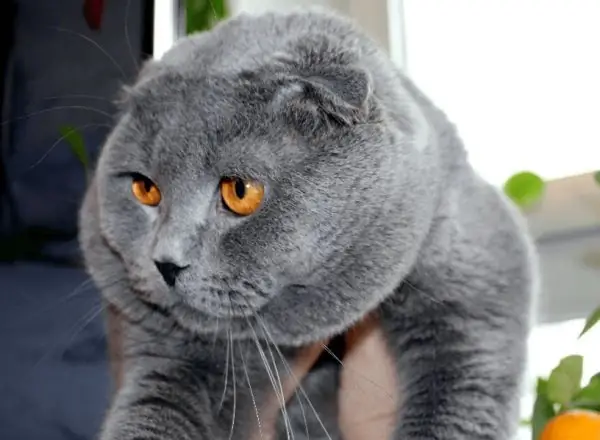
To get Levkoy, Ukrainians crossed the Don Sphynx with a Scottish Fold
Despite the lack of official recognition, the breeding of Ukrainian Levkoy is in full swing today. There are already at least four generations of representatives of this breed. Many of them were exported to Europe, and in Russia even created its own cattery of bald fold cats.
Video: Ukrainian Levkoy
Bambino
In 2005, a short-footed hairless kitten was born from a mating of a Canadian Sphynx and a Munchkin, which was named Bambino. The animal seemed to the owners so touchingly ridiculous that they decided: the success must certainly be consolidated. The unrecognized breed is sometimes called the dwarf cat.

Bambino is a hairless cat with short legs
The Munchkin is a cat breed based on a serious inherited disorder of the growth hormone receptor gene, as a result of which the long bones of the limbs stop growing. Unfortunately, this mutation, called achondroplasia, manifests itself as a dominant trait, which increases the likelihood of giving birth to a freak, but greatly facilitates selection work, the purpose of which is to consolidate an unusual appearance.

Munchkin - a cat with abnormally short legs
The possibility of a furless cat to live a full life can still be discussed. And already Munchkin achondroplasia, successfully transferred to a new breed, is definitely a serious pathology.
Video: bambino cat
Elf
Another miracle of American breeding is the elf cat, bred in 2006. In addition to the missing hair, the elf is adorned with an unusually turned inside out ears. This effect was obtained by crossing the Canadian Sphynx and the American Curl. Elves with bizarre patterns on their skin look especially "alien".
Photo gallery: bizarre elf colors
-

Elf light color - Elf skin can be smooth in color
-

Gray-pink elf color - Pink skin with gray areas gives the animal a special touching
-

Bicolor elf - Elf skin spots can be of any shape
-

Elf with a pattern all over the body - The multi-colored elf looks especially strange
-

Elf black and white - Sometimes spots on a cat's face resemble a Zorro mask.
Video: elf cat
Dwelf
The last chronologically bald cat breed is Dwelf. An unprecedented large-scale experiment involving the combination of three mutations at once was carried out by American breeders in 2007. Dwelf is a hairless cat with short legs and curved ears, the result of a crossing of the Canadian Sphynx, American Curl and Munchkin.
Photo gallery: breeding dwelf
-

Cat munchkin - Dwelf owes short paws to munchkin
-

Sphynx cat - The hairless gene for the creation of the Dwelf breed was borrowed from the Canadian Sphynx
-

American curl cat - Inverted ears - the calling card of the American curl
-

Dwelf - The breeders have outdone themselves in creating the dwelf
Video: Dwarf cat
Bald cat in the house: care features
Keeping a naked cat in the house is not as easy as it might seem. The hairless gene leaves a definite imprint on the character and behavior of the animal. Moreover, if some features are of a purely physiological nature, then the sources of others should be sought much deeper.
We can only guess what problems the owners of breeds that combine two or even three congenital pathologies may face. Therefore, it is not surprising that international felinological organizations are in no hurry to recognize the results of such experiments.
The myth of hypoallergenic hairless cats
Those who believe that bald cats are comfortable and easy to keep because they do not shed and, moreover, do not cause allergies, will be severely disappointed. Contrary to the existing misconception, allergies are caused not by cat's hair, but by specific proteins secreted by the endocrine glands of the animal. Modern science knows at least twelve "cat" allergens, which can be contained in:
- saliva;
- blood;
- urine;
- the secret secreted by the sebaceous glands;
- dandruff;
- the top layer of the skin.
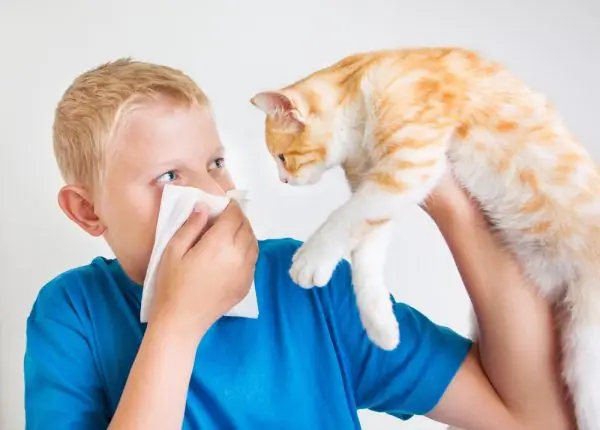
Allergy to cats does not depend on the length of their fur
In our minds wool is associated with allergies for two reasons:
- it easily tolerates allergens that get on it from the skin and saliva of the animal and, settling on various objects, causes a pathological reaction in us even at the moment when the animal has left the room long ago (some allergens remain in the house for six months after leaving it the cat disappeared);
- wool accumulates dust on itself, which is an independent and very dangerous allergen.
Thus, a bald cat can cause allergies just as much as a long-haired one.

Allergens are found in urine, saliva, cat blood and get on the skin, for example, when washing your face
Thermoregulation problems as payment for missing wool
Nature conceived a cat with the presence of wool. Bare skin causes serious discomfort to the animal, and as a result creates problems for the owner. There are four such problems:
- Bald cats are constantly freezing.
- Their skin is very sensitive to ultraviolet light and needs special protection.
- The lack of hair is compensated by untidy and easily soiled brown coating on the pet's skin.
- Hairless cats are hungry all the time.
These small troubles in the complex and make a bald cat a very "uncomfortable" pet, irritating an unprepared person.

Lack of hair makes life very difficult for a cat
Cold protection
Enthusiastic stories about how many different blouses and fashionable jumpsuits you can buy for your Sphynx do not really solve the problem of a freezing cat. Clothing impedes the movement of the animal and is perceived by it as an annoying hindrance.

Not all cats like to wear clothes
A cat prefers to escape the cold by crawling under a blanket, into clothes or other secluded place, sometimes spending almost all of its life there. Many owners complain that they see their sphinx only in the kitchen, where the pet comes running, heart-rendingly demanding food, and, having eaten, again hides in its nest.
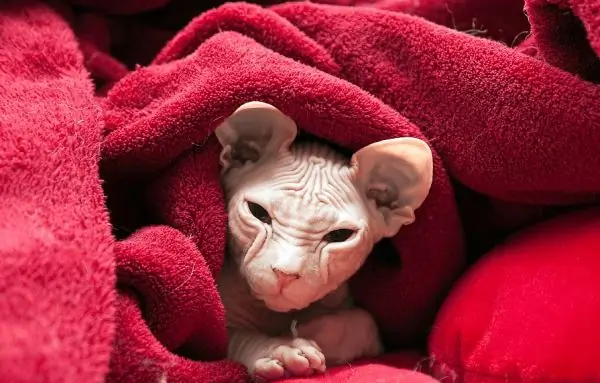
Hairless cats are always looking for a warm nest.
The vaunted affection of hairless cats is also often due only to the fact that the animal is simply trying to warm up, snuggling against a person. The suspicion that this is the price of a bald cat's love for its owner is expressed by many owners of these animals. This idea was most vividly expressed by my friend, noting that she clearly reads in the eyes of her Canadian sphinx, jumping on her lap: “I hate you! But you're warm."
Sun protection
Heat is no less problematic for bald cats than cold.
The owner of the Canadian Sphynx I mentioned, having suffered with her pet in cold Ireland, by the will of fate moved to live in Australia. She was happy with the thought that finally her beloved animal would stop freezing. But it was not there. Wanting to warm up, the cat on the very first day stretched out on the windowsill, exposing its sides to the gentle sun, and was burned so that it was necessary to go to the veterinarian. Now the cat is generously lubricated every day with baby sunscreen, which clogs the pores and causes various dermatitis, acne and other skin problems that do not add health, happiness or beauty to the animal.

The sphinx has delicate skin, which must be protected from direct sunlight: the animal can get burned, even sitting on the windowsill
Increased sweating
The lack of molting in hairless cats is compensated by a much more unpleasant moment: protecting the skin from aggressive environmental influences, the sebaceous glands of these animals produce a specific secret, similar in texture to wax. Hence the unkempt brown spots on the face, ears, belly, paws, and other parts of the sphinx's body. In addition to the fact that the cat looks unaesthetic, this wax-like plaque remains on literally everything that the animal touches.

Skin devoid of hair is covered with an uneven brown coating
Not every housewife is ready to calmly perceive dark greasy stains on upholstered furniture and find the same marks on freshly washed bed linen. Although plaque is fairly easily removed from the skin, this procedure is a poor solution. The more often the cleaning is carried out, the more actively the sebaceous glands work. The wax-like substance is intended to protect the naked skin of the cat, and therefore attempts to remove it exacerbate the aforementioned problems with the cat's well-being associated with the lack of hair.

Bathing is bad for any cat's skin
Constant hunger
Due to the almost continuous discomfort caused by the need to fight the cold, metabolic processes in the body of bald cats proceed at an accelerated rate. As a result, the animal constantly wants to eat and cannot always stop on time. Hence, in turn, additional problems arise:
- tendency to obesity, which is dangerous for the health of the cat and in the absence of hair looks especially ugly;
- increased likelihood of digestive disorders (sphinxes from greed are ready to swallow everything indiscriminately, while their digestive system is weaker than that of other breeds).
The owner of a bald cat is required to be very attentive to what and how much his pet eats.

Overweight bald cat looks just disgusting
Health status and most common diseases
The lack of hair in a cat, which seems so attractive to someone, causes a lot of inconvenience to the animal itself. Unfortunately, the mutation causing this trait is in some way linked to other health conditions. There are several diseases to which sphinxes are more susceptible than other cat breeds. Other mutation-based breeds have associated problems. By crossing such animals with sphinxes, we pass on to the offspring a predisposition to several groups of diseases at once.
A list of the most common hereditary diseases of the Sphynx, Scottish Fold and Munchkin will help the potential owner of a particular type of bald cat to form his own opinion about the ethics of creating such breeds.
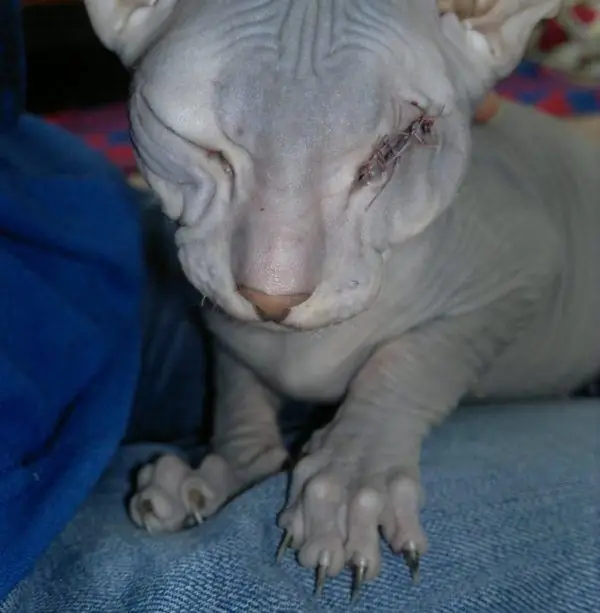
Eyes unprotected by eyelashes are one of the weak points of the sphinxes
Table: hereditary diseases common to hairless cats and their ancestors
| Breed name | Characteristic pathologies |
| Sphinxes |
|
| Scottish fold | Osteochondrodysplasia (a defect in the development of cartilage tissue). |
| Munchkin | Lordosis (weakening of the muscles that hold the spine), as a result, malfunction of all internal organs. |
Bald cats: owner reviews
A bald cat is unnatural, and therefore ugly. And it's not about subjective feelings, because, as you know, there is no dispute about tastes. It is simply impossible to admire the correctness of the animal's forms, knowing how tiny the size of its comfort zone is, and realizing that it was we, humans, who made the life of this animal so hard. Cats, undoubtedly, are among the most perfect creatures on this planet, so let us let them remain as nature created them - with hair, correct ears and paws of normal length!
Recommended:
Why Do Cats (including Pregnant) And Cats Dream: Interpretations Of Popular Dream Books, Descriptions Of Various Dreams About Kittens And Adult Animals

Why do cats, cats, kittens dream: interpretation from famous dream books. The meaning of the appearance of the animal, its condition and actions, as well as the sex of the dreamer
Hypoallergenic Cat Breeds: Types, Photos, Pet Choice And Keeping Rules, Owner Reviews

Causes of allergy to cats, myths and reality about the existence of hypoallergenic breeds, advice for allergy sufferers who dream of a cat
Spotted Cats: A List Of Wild And Domestic Cat Breeds, Photos, Owner Reviews

History of patterns on wool. What are the spotted types and breeds of cats. How to choose a spotted kitten, Reviews of spotted cats owners
Large Breeds Of Cats: Species With Photos, Features Of Care And Maintenance, Reviews Of Owners Of Large Cats

What are the big breeds of cats, what is necessary for keeping such a cat, how to feed and care for it
Popular Dog Breeds In Russia And The World - Photos, Names, Descriptions

Which dogs were the most in demand in 2019. Brief description of popular breeds
